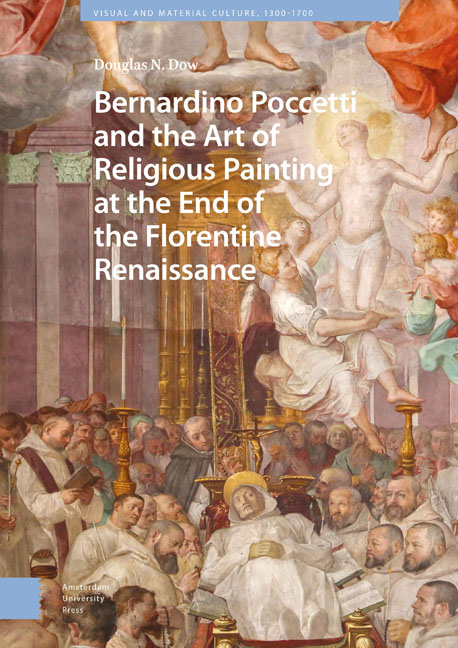Book contents
- Frontmatter
- Contents
- List of Illustrations
- List of Abbreviations
- Acknowledgments
- Introduction: ‘Il primo huomo da dipingere in fresco, che sia in questi paesi’: Bernardino Poccetti and the Historiography of Florentine Painting during the Late Renaissance
- 1 ‘Grandemente inclinato all’Arte del Disegno’: Filippo Baldinucci’s Biography of Bernardino Poccetti
- 2 ‘Le prime cose lodevoli molto’: Bernardino Poccetti’s Early Work and the Frescoes from the Life of Saint Dominic in the Chiostro Grande, Santa Maria Novella
- 3 ‘Locum ecclesiae designavit, quae Ioannis et uxoris pecunia extructa est’: Bernardino Poccetti and the Decoration of the Canigiani Chapel in Santa Felicita
- 4 ‘Miracula et alia id genus’: Bernardino Poccetti’s Frescoes in the Church of San Lorenzo at the Certosa del Galluzzo
- Color Plates
- 5 ‘L’inventore di dipingere tutte le muraglie della nostra chiesa’: Bernardino Poccetti and the Sixteenth-Century Decoration of Santa Maria del Carmine
- Conclusion
- Bibliography
- Index
Introduction: ‘Il primo huomo da dipingere in fresco, che sia in questi paesi’: Bernardino Poccetti and the Historiography of Florentine Painting during the Late Renaissance
Published online by Cambridge University Press: 13 February 2024
- Frontmatter
- Contents
- List of Illustrations
- List of Abbreviations
- Acknowledgments
- Introduction: ‘Il primo huomo da dipingere in fresco, che sia in questi paesi’: Bernardino Poccetti and the Historiography of Florentine Painting during the Late Renaissance
- 1 ‘Grandemente inclinato all’Arte del Disegno’: Filippo Baldinucci’s Biography of Bernardino Poccetti
- 2 ‘Le prime cose lodevoli molto’: Bernardino Poccetti’s Early Work and the Frescoes from the Life of Saint Dominic in the Chiostro Grande, Santa Maria Novella
- 3 ‘Locum ecclesiae designavit, quae Ioannis et uxoris pecunia extructa est’: Bernardino Poccetti and the Decoration of the Canigiani Chapel in Santa Felicita
- 4 ‘Miracula et alia id genus’: Bernardino Poccetti’s Frescoes in the Church of San Lorenzo at the Certosa del Galluzzo
- Color Plates
- 5 ‘L’inventore di dipingere tutte le muraglie della nostra chiesa’: Bernardino Poccetti and the Sixteenth-Century Decoration of Santa Maria del Carmine
- Conclusion
- Bibliography
- Index
Summary
Abstract: Bernardino Barbatelli (called Poccetti, 1553–1612) was a successful fresco painter in late sixteenth-century Florence, yet he remains largely overlooked by contemporary scholarship. In addition to the obstacles posed by his prolific output and the inaccessibility of his monumental murals, this chapter examines historiographical reasons for Poccetti's obscurity, exploring how shifting artistic styles and aesthetic tastes led early Seicento commentators to see the last half of the Florentine Cinquecento as a period of stagnation. This narrative was later reinforced by the preferences of nineteenth- and twentieth-century art historians, which reflected modernist ideas of artistic innovation and stylistic progression. Historical evidence shows, however, that Poccetti's contemporaries valued his works as a continuation of an esteemed tradition of Florentine fresco painting.
Keywords: Bernardino Barbatelli (called Poccetti); Florence; Renaissance; fresco; Historiography
In April of 2021, as this book was well underway and the world was in the grip of the COVID-19 pandemic, renovations undertaken at the Uffizi revealed two frescoed portraits of Medici rulers by the hand of Bernardino Barbatelli, now known as Bernardino Poccetti (1553–1612). By almost any measure, Poccetti was one of the most successful fresco painters in late sixteenth-century Florence, and however serendipitous this discovery might have been, it is by no means surprising. Poccetti and his workshop painted an impressive number of monuments for a wide range of patrons throughout the city, an achievement that did not escape the attention of the painter's earliest biographer, Filippo Baldinucci (1625–1696). In his discussion of Poccetti published in the Notizie de’ professori del disegno da Cimabue in quà (6 vols., 1681–1728), Baldinucci remarked that it would be an ‘impossible task’ (‘cosa impossibile’) to describe the entire oeuvre of this prolific Florentine painter, and so he warned his reader that he would limit himself to mentioning ‘only a few, indeed very few, and almost none’ of Poccetti's many paintings in Florence and elsewhere. In this respect, the seventeenth-century biographer was neither shirking his duty nor overstating the case, for Poccetti and his collaborators executed an impressive number of commissions. At the close of the eighteenth century, Luigi Lanzi (1732–1810) echoed Baldinucci's description, remarking that although his work on panel or canvas was rare, Poccetti's frescoes could be found in ‘nearly every corner in Florence’ (‘pressochè in ogni angolo di Firenze’).
- Type
- Chapter
- Information
- Bernardino Poccetti and the Art of Religious Painting at the End of the Florentine Renaissance , pp. 19 - 42Publisher: Amsterdam University PressPrint publication year: 2023



